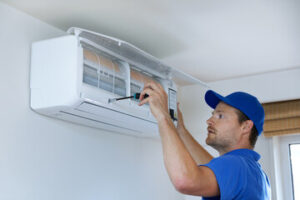A HVAC system is a complex machine that requires a lot of work to install. It can involve removing old equipment and installing new air ducts and vents. It also involves ensuring that there is proper insulation and repairing or sealing leaks.
When choosing an HVAC contractor, it is important to get an in-person quote. This will allow them to see the home layout and take measurements. They will also be able to compare costs and warranties. Visit proairconditioningrepairhendersonnv.com to learn more.

Many things can affect the cost of installing a new HVAC system. For example, the type of unit you choose can make a significant difference. A straight electric unit will be more affordable than a gas-powered model. The size of the unit can also make a big difference in price. A bigger unit will require more materials and installation labor, so it will generally be more expensive.
The type of ductwork needed is another factor that can influence the cost. For example, ductwork that has to be replaced due to leaks will cost more than ductwork that is in good condition. The location of the HVAC unit can also affect the cost, as it may be more expensive to install in a difficult to reach area of the home.
Before you begin the hvac installation process, it is important to get quotes from several contractors. This will give you an idea of how much the entire project will cost. Some contractors will charge by the hour, while others will charge a flat rate. Ask each contractor how they calculate their rates to ensure you are getting an accurate quote.
In addition to determining the type and size of HVAC system needed, contractors must also assess the space in order to determine how much heating or cooling capacity is required. This is done by calculating the heat load of the space and taking into account factors like the number of windows, insulation, and room size. A properly sized HVAC system can save you money in the long run by not overworking the equipment.
When choosing an HVAC system, it is important to consider the long-term costs as well as the upfront cost. A high-efficiency HVAC system will cost more up front, but it can save you money in the long run by lowering your energy bills. Also, consider any tax rebates or green energy incentives that may be available to you.
When installing a new HVAC system, it is important to work with a reputable company. This will help to ensure that the job is done correctly and that you are getting the best value for your money. In addition, a reputable company will stand behind their work and provide customer service if you ever have any issues with your system.
Cost of Installation
The type and size of the HVAC system you choose is a key factor in the cost. You may also need to consider a number of accessories and upgrades, such as smart thermostats that integrate with your home’s other systems and phone apps for convenience and functionality, or whole-house air purifiers and dehumidifiers.
The contractor’s hourly rate also contributes to the overall installation cost. The best way to ensure you’re getting the most accurate quote is to have a technician come and visit your home. They’ll take measurements and assess your home layout and space requirements. This will help them determine the proper equipment size for your home and give you an itemized proposal with costs, warranties, and options. You can then compare the quotes to make the most informed decision.
You’ll also need to decide whether you want a ducted or ductless system. A ductless system uses compact, flexible tubing instead of ducts, making it easier to install in older homes and reducing installation costs. Ductless systems also tend to be more energy efficient and provide better air quality than traditional ducted systems.
During the installation process, the contractor will first remove the old HVAC unit and then replace or repair the ductwork. They’ll connect the ductwork to the air handler, which circulates cool and warm air throughout your home to achieve the desired temperature. They’ll also connect the indoor and outdoor units, ensuring refrigerant lines are connected properly.
Once the installation is complete, a technician will test the system and walk you through the operation of your new HVAC. They’ll also inspect the work they performed and answer any questions or concerns you might have.
A few days after the installation, a technician will return to your home and perform a follow-up inspection. They’ll check the thermostat, test the air flow and ensure everything is running properly. This is an important part of the installation process, as it ensures your HVAC system is working correctly and efficiently. It’s also a great opportunity for the technician to give you tips on how to maintain your new system and help you get the most out of it.
Cost of Labor
HVAC installation is a meticulous process that transforms a home into an energy-efficient hub of comfort. It requires expert knowledge of local climate conditions, proper unit sizing, and a comprehensive evaluation of the home’s layout and insulation quality. Homeowners should prepare for the process by clearing obstacles and arranging their schedules to accommodate professional HVAC technicians. Ideally, they should clear a spot outdoors for the unit and find a location indoors where it will be easily accessible for future maintenance.
The first step in the process involves a load calculation to determine the size of the AC unit that will be needed to adequately heat or cool the space. This is crucial because an undersized unit will overwork itself to keep the house at a comfortable temperature, leading to costly breakdowns and unnecessary energy consumption. On the other hand, an oversized unit will cycle on and off frequently and may lead to high utility bills.
After the load calculation is completed, the professionals will begin to install the new system. This includes removing the old unit and preparing the outdoor space for the new one. They will also install or replace the ductwork, which carries air from the indoor to the outdoor unit and controls how much air gets in and out of the space.
HVAC installers should use certified tools to ensure that the work is done properly. This will help them avoid costly mistakes and save money in the long run. They will also need to know how to troubleshoot common problems, such as frozen air vents or faulty thermostats, and offer effective solutions.
In addition to installing the AC unit, they will also need to connect the ductwork and refrigerant lines. This will ensure that the ductwork is in good condition and that the conditioned air is flowing through it effectively. They will also need to test the airflow and pressure in the ducts, which is important for efficiency.
In order to maximize efficiency, homeowners should choose a system that has a high SEER rating and invest in routine maintenance. In addition, they should explore options for utilizing existing ductwork and consider replacing any insulators that are damaged or worn down. Finally, they should schedule the installation during off-peak seasons when professional HVAC technicians offer lower rates.
Financing
If you are replacing your HVAC system because it is broken or to improve the energy efficiency of your home, then financing can be a good option. Financing enables you to buy a higher-quality system that will save energy costs and money in the long run. Financing is especially useful if your existing system fails during a cold snap or heatwave.
The first step to finding the right financing is to shop around and compare different options. Personal loans, credit cards and home equity lines of credit are common financing options. You can also look for rebates and incentives, which can reduce the upfront cost of a new system.
Some financing providers offer specialized loans for HVAC systems, which can provide lower interest rates or deferred payments. You will have to submit a full application along with documents like your W-2s, bank statements and tax forms to get approved for the loan. A credit score of at least 670 is usually required for this type of loan.
Another way to finance an HVAC system is through a home improvement loan, which typically comes with fixed interest rates and repayment terms. These are available through banks, credit unions and online lenders. They are a good option if you have high credit and debt-to-income ratios, which can make them easier to qualify for.
A home equity line of credit (HELOC) is a popular choice because it allows you to access the equity in your home whenever you need it. However, you should remember that you will have to pay interest on the funds borrowed from your home equity, and the monthly payment can vary over time.
Some manufacturers and financing companies offer specific HVAC financing plans that can include perks like low or 0% interest, deferred payments and special offers on qualifying systems. These programs can help you afford a more efficient system that will save you money in the long run, so it’s worth checking them out. Also, ask potential financing companies for references from happy customers so you can assess their reliability and reputation.

